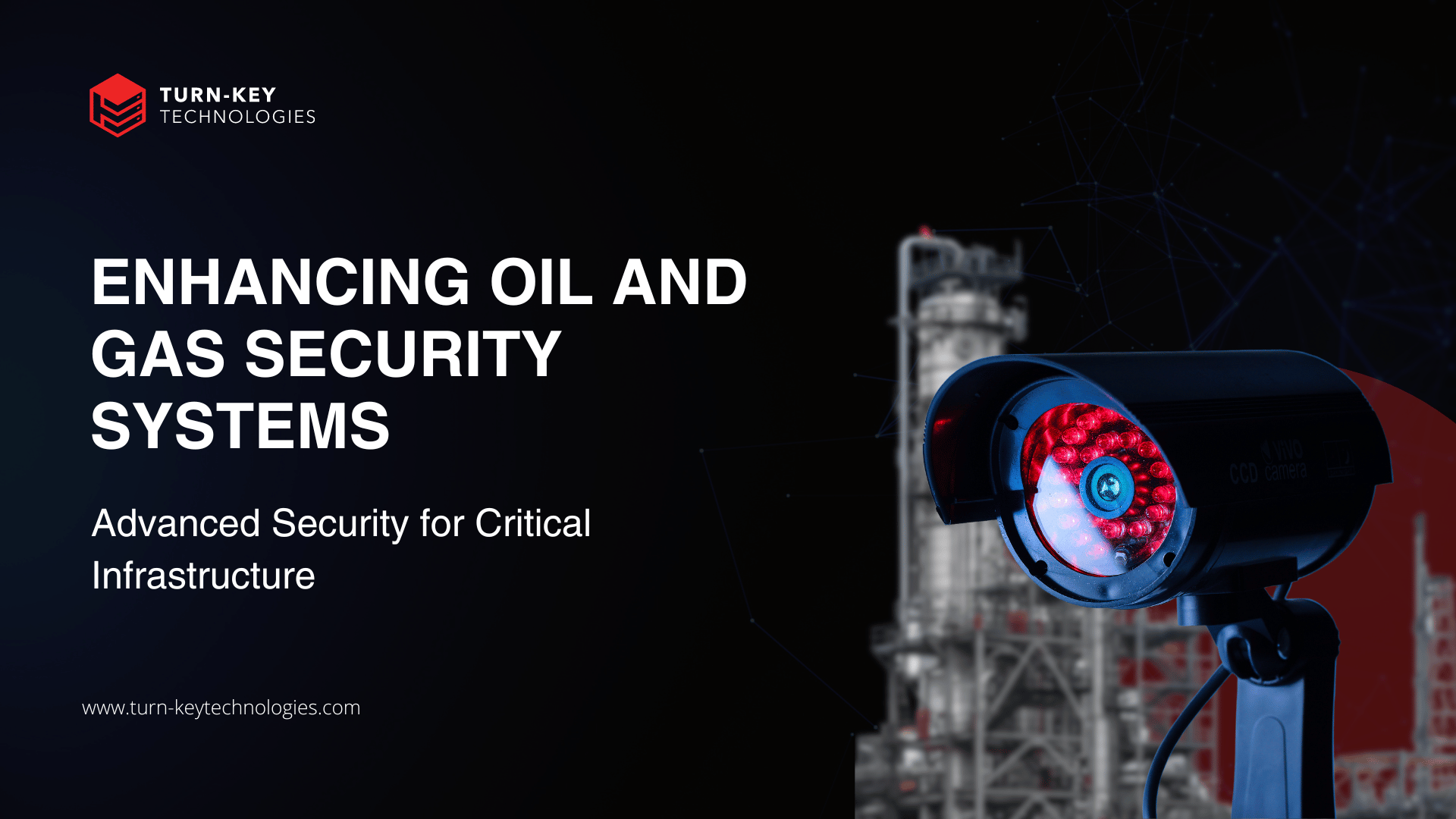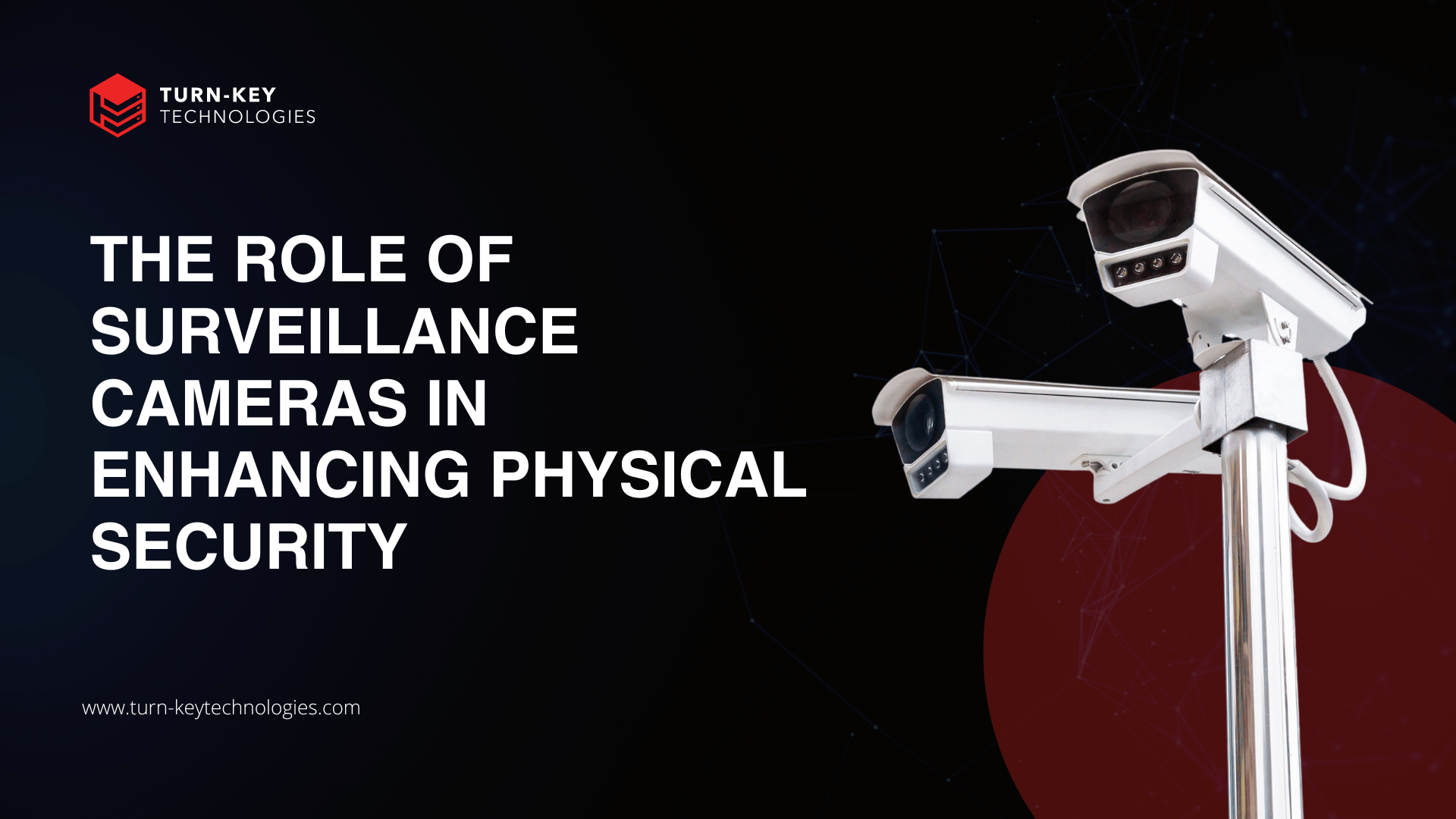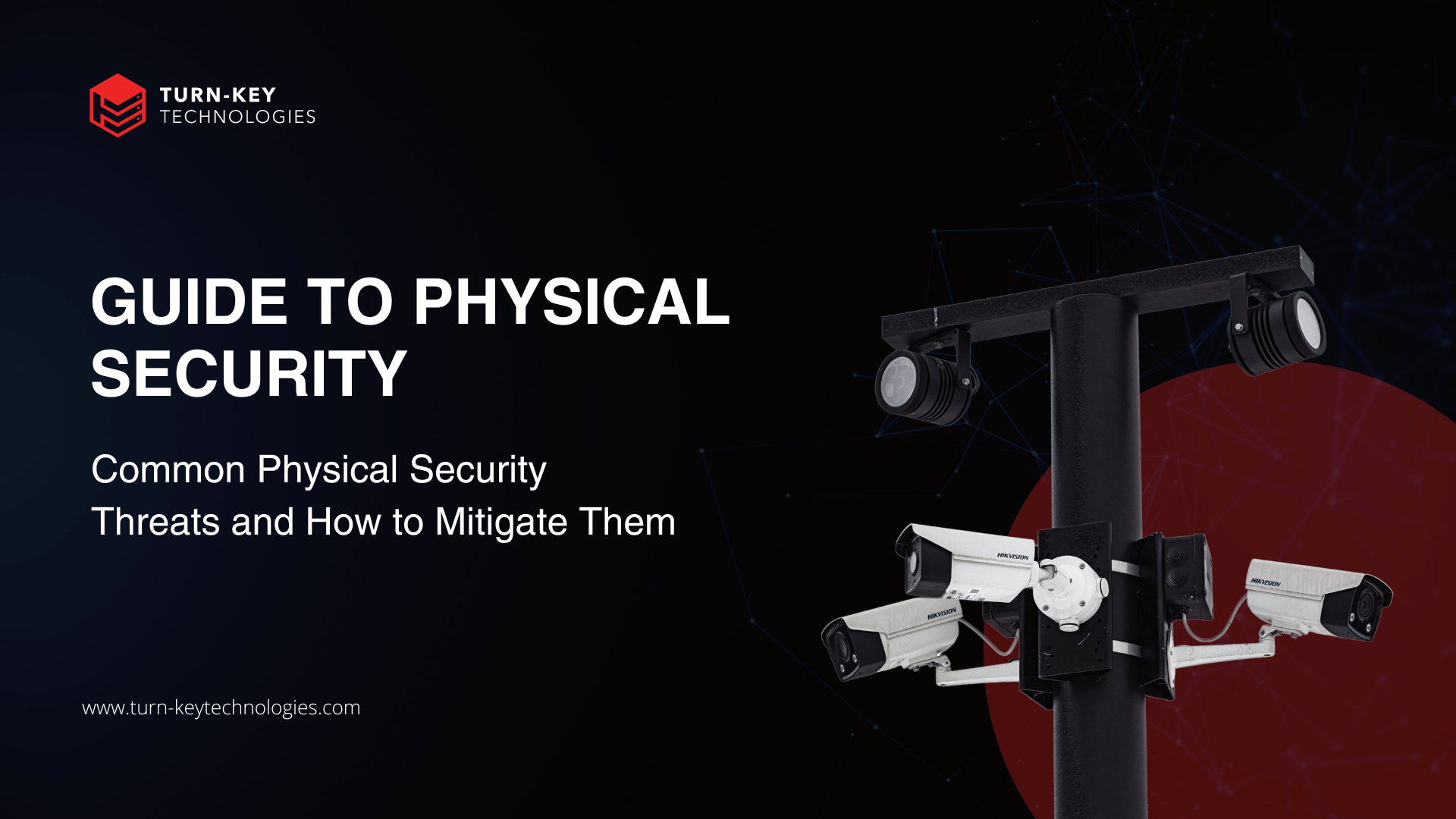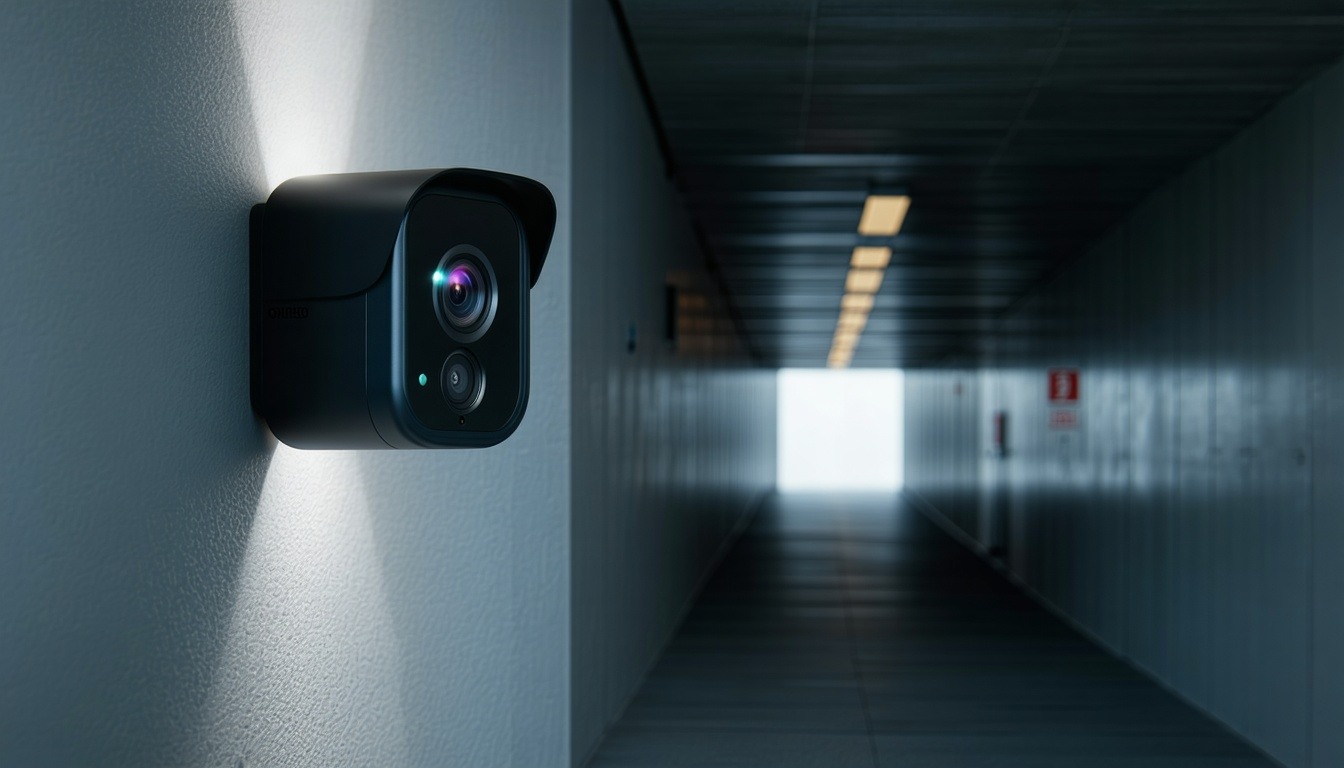The Role of Surveillance Cameras in Enhancing Physical Security
The physical security market is experiencing significant growth, with projections indicating it will expand at a CAGR of 8.03% from 2023 to 2028,...
13 min read
Turn-key Technologies Staff : Jun 13, 2024 4:10:54 PM

The oil and gas industry is a cornerstone of global energy supply and economic stability, making infrastructure security paramount. From pipelines to refineries and drilling rigs, the sector faces threats like cyberattacks, terrorism, and environmental hazards. Robust security measures are critical to preventing disruptions that can cause significant economic losses, environmental disasters, and national security threats. Advanced surveillance, intrusion detection, and cybersecurity systems are vital in safeguarding these assets and protecting both the industry and the communities that rely on its stability.
TL;DR: Oil and gas security is crucial because of the industry's vital role in global energy supply and economic stability. Threats such as cyberattacks, terrorism, and environmental hazards require robust security measures to prevent severe economic, environmental, and national security impacts. Advanced security systems are essential to protect critical infrastructure and ensure continuous operation.
The oil and gas industry is crucial to the global energy supply chain and economic growth. Securing its infrastructure, including pipelines, refineries, drilling rigs, and storage facilities, is essential to prevent disruptions with significant consequences. Security breaches can lead to environmental disasters, financial losses, and national security threats, making robust security systems vital for maintaining stability and efficiency in this sector.
The threat of terrorism and sabotage is a primary reason for stringent oil and gas security. These facilities are high-value targets for terrorist groups aiming to cause widespread disruption. Attacks can lead to severe economic and environmental damage, making robust security measures necessary. Advanced surveillance, intrusion detection, and access control systems can deter attacks and protect critical infrastructure, ensuring the safety of personnel and communities.
Environmental protection is another key aspect of oil and gas security. Handling hazardous materials during extraction, transportation, and processing poses risks of spills, leaks, and accidents. Comprehensive security systems enable rapid detection and response to potential threats, preventing long-term ecological harm and ensuring regulatory compliance. Early detection through sensors and surveillance can mitigate environmental impacts.
Financially, security breaches can result in costly repairs, legal liabilities, and revenue loss. A single pipeline sabotage incident can halt millions of barrels of oil transportation, leading to substantial economic losses. Investing in robust security measures, such as remote video surveillance and real-time alerts, minimizes downtime and supports continuous operations, making it a sound financial strategy.
Geopolitically, oil and gas resources are critical to national security, as countries depend on them for economic stability. Protecting infrastructure from cyber-attacks, espionage, and sabotage is essential. Security systems incorporating AI-driven analytics and cybersecurity protocols safeguard these assets against evolving threats, supporting energy independence and economic resilience.
The oil and gas sector faces unique security challenges due to its widespread and often remote infrastructure. Pipelines, oil rigs, refineries, and storage facilities span vast areas, frequently in isolated locations, making them difficult to monitor and secure. This physical dispersion increases vulnerability to attacks, theft, vandalism, and environmental hazards. Effective security measures must ensure comprehensive coverage and rapid response despite these logistical challenges.
A major security concern in the oil and gas industry is terrorism and sabotage. These facilities are high-value targets for terrorist organizations seeking to cause disruption and economic damage. Protecting these assets requires a multi-layered approach, including perimeter security, intrusion detection, and real-time surveillance. Advanced technologies like drones and thermal imaging enhance monitoring in hard-to-reach areas, providing additional protection.
Cybersecurity is another critical issue. With increasing reliance on digital systems, the risk of cyber-attacks grows. Such attacks can disrupt production, compromise sensitive data, and cause physical damage. The integration of Industrial Control Systems (ICS) with IT networks has created new vulnerabilities. Protecting against these threats requires robust cybersecurity measures, including firewalls, intrusion detection, and regular security audits. Employee training on cybersecurity best practices is essential to prevent human error.
Environmental conditions also pose challenges. Extreme weather events like hurricanes, floods, and earthquakes can damage facilities and disrupt operations. Climate change is increasing the frequency and severity of these events. Resilient security systems that withstand harsh conditions are necessary. Surveillance equipment must be ruggedized for extreme temperatures, high humidity, and corrosive environments. Regular maintenance and updates to security systems are crucial.
The human element in security management is vital. Ensuring the safety and security of personnel includes protecting them from external threats and implementing safety protocols to prevent accidents. Security personnel need training and equipment to handle threats and emergencies. Fostering a culture of security awareness among all employees is crucial. Regular drills, training sessions, and clear communication channels help build a vigilant and prepared workforce.
In addition to these measures, obtaining ISNetworld certification is increasingly important. This certification helps ensure that companies meet stringent safety and security standards, providing a framework for managing contractor and supplier relationships. ISNetworld certification demonstrates a commitment to maintaining high safety and compliance standards, enhancing overall security and operational integrity.
Understanding these security challenges is the first step towards developing comprehensive solutions to protect the oil and gas sector’s infrastructure. Addressing physical, cyber, environmental, and human factors, along with adhering to standards like ISNetworld certification, enhances security and ensures safe and efficient operations in a complex threat landscape.
Security cameras are crucial for enhancing the safety and security of oil and gas infrastructure. These systems provide constant surveillance, enabling real-time monitoring of vast and often remote sites. Strategically placed cameras around pipelines, refineries, and drilling rigs allow operators to keep an eye on their assets 24/7. This continuous oversight helps deter unauthorized access and quickly alerts security personnel to any suspicious activities or potential threats, enabling a swift and effective response.
Modern security cameras come equipped with advanced features that improve their functionality and reliability in challenging environments. High-definition (HD) and ultra-high-definition (UHD) cameras capture detailed images, making it easier to identify intruders or detect anomalies. Night vision capabilities ensure effective surveillance even in low-light conditions, crucial for round-the-clock operations. Additionally, thermal imaging cameras detect heat signatures, useful for spotting leaks or unauthorized personnel in areas where visibility is compromised.
Integration with video analytics further enhances the role of security cameras in oil and gas security. Video analytics software can analyze live feeds in real-time, identifying patterns and behaviors that indicate security threats. For example, the software can detect unusual movement, loitering, or perimeter breaches, automatically triggering alerts for security personnel. This technology reduces the burden on human operators by filtering out false alarms and focusing on genuine threats, increasing the security system's efficiency and effectiveness.
Security cameras also play a vital role in incident investigation and documentation. In the event of a security breach, accident, or operational failure, recorded footage provides valuable evidence for understanding what happened and how it occurred. This information is essential for conducting thorough investigations, identifying culprits, and improving security protocols to prevent future incidents. Moreover, the presence of security cameras acts as a deterrent to potential vandals or intruders who are less likely to target facilities under constant surveillance.
Besides enhancing security, cameras contribute to the overall safety and operational efficiency of oil and gas facilities. They monitor the condition of equipment and infrastructure, identifying issues like wear and tear or potential leaks before they become critical problems. Proactive monitoring allows for timely maintenance and repairs, reducing the risk of accidents and operational downtime. By continuously observing all aspects of the facility, security cameras support a safer and more efficient working environment, protecting both assets and personnel.
Implementing effective surveillance systems in oil and gas sites is essential for protecting critical infrastructure from various threats. Given the vast and remote locations of these facilities, a comprehensive surveillance strategy is necessary to monitor activities, detect intrusions, and respond to incidents promptly. Effective surveillance integrates multiple technologies, including high-definition cameras, thermal imaging, and motion detection sensors, to provide continuous and reliable monitoring. This multi-layered approach ensures that potential security breaches are detected and addressed swiftly, minimizing the risk of damage or disruption.
A primary component of an effective surveillance system is the strategic placement of security cameras. Positioning cameras at key points, such as entry and exit points, critical infrastructure, and perimeter boundaries, ensures comprehensive site coverage. High-definition and thermal cameras are particularly useful in oil and gas environments as they capture clear images in various lighting and weather conditions. Additionally, pan-tilt-zoom (PTZ) cameras can cover large areas and focus on specific points of interest, enhancing overall surveillance capability.
Integrating video analytics is crucial for enhancing the effectiveness of surveillance systems. Video analytics software processes live feeds in real-time, identifying patterns and behaviors that may indicate security threats. For example, the software can detect unauthorized access, loitering, or unusual movement, automatically triggering alerts for security personnel. This capability improves monitoring efficiency and reduces false alarms, allowing security teams to focus on genuine threats. Leveraging artificial intelligence and machine learning, video analytics continuously improve accuracy and adaptability, providing a robust layer of protection.
Remote monitoring capabilities significantly enhance surveillance effectiveness, particularly in remote or inaccessible areas. Remote video surveillance allows security personnel to monitor live feeds and review recorded footage from a centralized location, reducing the need for an on-site presence. This capability is valuable for monitoring offshore drilling platforms or remote pipelines where physical access is challenging. Advanced communication technologies, such as satellite and wireless networks, ensure that remote surveillance systems remain connected and functional, even in isolated locations.
An effective surveillance system should be integrated with other security measures for a holistic site protection approach. Access control systems, intrusion detection sensors, and alarm systems should work seamlessly with surveillance cameras and video analytics to create a cohesive security infrastructure. Regular maintenance and updates are essential to ensure that all components remain operational and effective. Training security personnel to manage the surveillance system effectively is also crucial, as human oversight is critical in responding to security incidents.
Moreover, adhering to standards like ISNetworld certification is crucial. This certification ensures companies meet stringent safety and security standards, providing a framework for managing contractor and supplier relationships. ISNetworld certification demonstrates a commitment to high safety and compliance standards, enhancing overall security and operational integrity.
Pipeline security is vital for the oil and gas industry, as pipelines transport crucial energy resources over long distances. Ensuring their security is key to maintaining a stable energy supply. Often in remote and challenging areas, pipelines face threats like physical attacks, vandalism, and natural disasters. Comprehensive security measures are necessary to protect these infrastructures and ensure the continuous flow of oil and gas.
Advanced surveillance systems are essential for pipeline security. High-definition cameras, thermal imaging, and motion sensors can continuously monitor pipeline routes, detecting unauthorized activities or anomalies. These systems provide real-time data to security personnel for rapid threat response. Video analytics enhance these systems by identifying suspicious behavior and triggering alerts for swift intervention.
Physical security measures are also crucial. Robust fencing, barriers, and access control systems prevent unauthorized entry. Sensors along the pipeline detect intrusion or sabotage attempts. Fiber-optic sensors can detect vibrations from digging or tampering, and pressure sensors can identify leaks or ruptures. Combining these physical measures with advanced surveillance creates a multi-layered defense system that significantly reduces security breaches.
Remote monitoring capabilities are critical due to the extensive and often remote nature of pipeline networks. Remote video surveillance allows operators to monitor pipeline integrity from a central location. Satellite and wireless communication technologies transmit live video feeds and sensor data, ensuring continuous oversight. This capability is particularly valuable for offshore pipelines and pipelines in difficult terrains.
Regular maintenance and inspection protocols are also essential for pipeline security. Drones, robotic systems, and other technologies can identify vulnerabilities like corrosion and structural weaknesses. Predictive maintenance strategies, supported by data analytics, help identify potential issues before they become significant problems. Training personnel in the latest security practices ensures effective response to incidents. By integrating surveillance, physical security, remote monitoring, and regular maintenance, oil and gas companies can protect their pipelines against a wide range of threats.
Remote video surveillance has transformed how oil and gas companies oversee their facilities, offering efficient monitoring from afar. Due to the expansive and isolated nature of these sites, traditional security methods are often impractical and costly. Remote surveillance provides continuous monitoring, ensuring comprehensive site coverage. This technology uses advanced communication networks, such as satellite and wireless connections, to transmit live video feeds to centralized monitoring centers, allowing for real-time situational awareness and quick incident response.
A key benefit of remote video surveillance is enhanced security without extensive on-site personnel. High-definition cameras with night vision and thermal imaging maintain vigilant surveillance in all conditions. Strategically placed along pipelines, drilling rigs, and entry points, these cameras capture detailed footage. Pan-tilt-zoom (PTZ) cameras allow operators to focus on specific areas and track movements, providing a detailed view of potential threats.
Advanced video analytics further enhance these systems. Software can analyze live feeds, detecting anomalies like unauthorized access or tampering, and immediately alert security personnel. This reduces the need for constant human monitoring, enabling operators to focus on verified threats and respond more efficiently. By filtering out false alarms, video analytics improve overall security.
The scalability of remote video surveillance is ideal for the oil and gas industry. As operations expand, additional cameras and sensors can be easily integrated into the existing network. This flexibility ensures that security measures evolve with the company's infrastructure. Additionally, remote systems can be accessed from multiple locations, allowing simultaneous monitoring of different sites. This centralized approach enhances coordination and ensures a unified response to incidents.
Beyond security, remote video surveillance improves operational efficiency and safety. Continuous monitoring can identify issues like leaks or equipment malfunctions, enabling prompt intervention and minimizing downtime. Recorded footage can be used for training, enhancing safety protocols and regulatory compliance. Overall, remote surveillance provides a comprehensive solution for monitoring oil and gas sites, enhancing both security and operational effectiveness.
By leveraging remote video surveillance, oil and gas companies gain better oversight and control of their operations. This technology not only boosts security but also supports efficient management and safety practices, protecting valuable assets and ensuring personnel well-being. As the industry evolves, remote video surveillance will remain a critical component of a robust security strategy, helping companies navigate an increasingly complex operational environment.
Video analytics is essential in enhancing oil and gas surveillance systems, providing advanced capabilities to detect and respond to security threats. Traditional surveillance methods often fall short in the vast and complex environments of oil and gas operations. Video analytics leverages artificial intelligence (AI) and machine learning (ML) to process and interpret video footage in real-time, offering proactive security measures beyond passive monitoring.
One key benefit of video analytics is its ability to automatically identify and alert personnel to suspicious activities. This technology can detect unauthorized access, loitering, equipment tampering, and other unusual behaviors indicating a security breach. By distinguishing between normal operations and potential threats, video analytics significantly reduces false alarms, allowing security teams to focus on genuine incidents and improve response times.
In addition to threat detection, video analytics enhances operational efficiency and safety. It can monitor the movement of personnel and vehicles within a facility, ensuring compliance with safety protocols and identifying deviations that could lead to accidents. By providing insights into operational activities, video analytics helps optimize workflows, reduce incident risks, and maintain consistent safety standards, making it a valuable asset for oil and gas companies.
Integrating video analytics with other security and operational systems amplifies its benefits. When combined with access control systems, sensors, and alarms, video analytics provides a comprehensive security solution. For instance, if a sensor detects a drop in pipeline pressure, video analytics can immediately review footage from nearby cameras to assess the situation. This integrated approach enables a coordinated response, minimizing operational impacts and ensuring prompt issue resolution.
Video analytics also offers significant scalability and adaptability. As operations expand or evolve, video analytics systems can be easily updated and scaled to meet new requirements. Continuous improvements in AI and ML algorithms ensure these systems become more accurate and efficient over time, adapting to new threats and changing conditions. This flexibility makes video analytics a future-proof investment, providing long-term security and operational benefits.
Integrating sensor technology into oil and gas security systems is crucial for creating a robust and responsive security infrastructure. Sensors provide real-time data on environmental and operational conditions, enabling immediate detection and response to potential threats. They can monitor parameters like pressure, temperature, vibration, and unauthorized access, ensuring comprehensive coverage and protection of critical assets. Leveraging sensor technology, oil and gas companies can significantly improve their ability to prevent, detect, and respond to security incidents.
One key benefit of sensor technology is early warning of potential security breaches or operational issues. Pressure sensors along pipelines can detect pressure changes, indicating leaks or unauthorized tapping. Vibration sensors can identify tampering or sabotage attempts. When integrated with surveillance systems, these sensors can trigger alerts and activate nearby cameras to capture real-time footage. This proactive approach allows security teams to address issues before they escalate, minimizing damage and operational disruption.
Sensor technology also improves the accuracy and reliability of security systems by reducing false alarms. Traditional security measures, like motion detectors or cameras, can produce false positives due to environmental factors. Sensors, however, measure specific parameters and are less susceptible to such interferences. Integrating sensors with video analytics and other technologies creates a multi-layered security system that provides precise and actionable intelligence, enhancing overall security effectiveness.
The versatility of sensor technology allows for its application across various oil and gas operations, from onshore drilling sites to offshore platforms and pipelines. Environmental sensors monitor conditions like temperature, humidity, and gas concentrations, ensuring equipment operates safely and detecting hazards like gas leaks or fires. Access control sensors monitor entry and exit points, ensuring only authorized personnel access sensitive areas. Deploying diverse sensors enables oil and gas companies to achieve a comprehensive security approach, covering all potential vulnerabilities.
Integrating sensor technology also supports predictive maintenance strategies. Sensors continuously collect data on equipment condition and performance, identifying wear and tear or other issues before failures occur. Analyzing this data predicts maintenance needs, reducing the risk of unexpected breakdowns and improving operational efficiency. Predictive maintenance enhances the reliability and safety of infrastructure while optimizing resource allocation and reducing costs.
Addressing environmental conditions is crucial for effective surveillance in the oil and gas industry. These sites are often in harsh environments, like offshore platforms, deserts, and arctic regions, where extreme weather can impact surveillance performance. Ensuring that security equipment can withstand these conditions is essential for reliable monitoring, requiring robust and durable technologies that operate efficiently in various scenarios.
Camera Durability and Functionality
One primary challenge is ensuring surveillance cameras function in extreme temperatures. Standard cameras may fail in scorching heat or freezing cold. High-quality cameras with environmental housings and heating or cooling elements are necessary for reliable operation. These cameras should be made from corrosion-resistant materials to endure exposure to saltwater, chemicals, and other corrosive elements common in oil and gas environments. Regular maintenance and inspections are crucial for ensuring the longevity and performance of this equipment.
Visibility Issues
Dust storms, heavy rain, fog, and snow can impair traditional surveillance systems. Deploying thermal imaging cameras and infrared sensors helps maintain clear images in low-visibility conditions. These technologies are particularly useful for night operations or adverse weather, ensuring continuous site monitoring. Integrating these advanced imaging technologies with existing systems enhances their effectiveness and reliability.
Wind and Vibration Challenges
Wind and vibrations can affect surveillance accuracy by causing cameras to shake, resulting in blurred images and unstable video feeds. To mitigate these issues, surveillance systems should be mounted on stable platforms and equipped with vibration-damping technology, ensuring clear footage despite external disturbances. Advanced video stabilization software can also enhance image quality by correcting residual movement.
Power Supply and Connectivity
Reliable power supply and connectivity are critical for surveillance systems in remote oil and gas locations. Off-grid or hard-to-reach areas pose challenges for continuous operation. Solar panels, wind turbines, and battery backups offer sustainable power solutions. Connectivity for transmitting video feeds and data to central monitoring stations is equally important. Satellite and wireless communication technologies ensure that surveillance systems stay connected, even in remote locations. Implementing redundant systems and failover mechanisms guarantees uninterrupted monitoring, enhancing overall security.
Enhancing security measures in oil and gas operations requires a multifaceted approach combining advanced technology, comprehensive risk management strategies, and continuous improvement. Implementing best practices ensures security systems are effective, resilient, and capable of addressing the industry's unique challenges.
Conduct Regular Risk Assessments
Conduct regular risk assessments to identify vulnerabilities and potential threats. By thoroughly evaluating the security landscape, oil and gas companies can develop targeted strategies to mitigate risks, prioritize resource allocation, and strengthen their overall security posture.
Integrate Advanced Surveillance Technologies
Integrate advanced surveillance technologies, including high-definition cameras, thermal imaging, and video analytics, for real-time monitoring and threat detection. These technologies should be strategically placed around critical infrastructure, such as pipelines, refineries, and drilling rigs, to ensure comprehensive coverage. Integrating surveillance systems with other security measures, like access control and intrusion detection, enhances situational awareness and enables rapid response to security incidents.
Implement a Robust Cybersecurity Framework
As oil and gas operations increasingly rely on digital systems, the risk of cyber-attacks has grown. Protecting against these threats requires regular vulnerability assessments, firewalls, intrusion detection systems, and continuous network activity monitoring. Training employees on cybersecurity best practices is crucial to prevent human error. Fostering a culture of cybersecurity awareness helps safeguard digital assets and operational technologies.
Strengthen Physical Security Measures
Physical security measures are crucial for protecting oil and gas facilities. Install barriers, fences, and secure access points to prevent unauthorized entry. Regular patrols and visible security personnel deter potential intruders. Advanced access control systems using biometric verification and smart card technology ensure only authorized personnel access sensitive areas. Combining physical security with technological solutions creates a layered defense strategy that enhances critical infrastructure protection.
Commit to Continuous Improvement and Training
Security technologies and threats are constantly evolving, requiring ongoing updates and upgrades to security systems. Regular training sessions and drills for security personnel ensure preparedness for incidents and understanding of the latest security protocols. Establish a feedback loop to analyze security incidents and integrate lessons learned into future strategies. Continuous improvement helps stay ahead of emerging threats and maintain a robust security posture.
Oil and gas security is a complex and critical aspect of the industry, requiring advanced systems and technologies to protect valuable assets and infrastructure. By implementing comprehensive security solutions, including surveillance cameras, remote video surveillance, and video analytics, oil and gas companies can effectively address security challenges and maintain safe and efficient operations.
If you’re looking for a vendor at the forefront of enterprise video surveillance systems, look no further than Turn-key Technologies, Inc. (TTI). With help from our experts, you can have a reliable security camera system with a network capable of supporting it up and running in no time. What’s more, we offer an unprecedented level of support through our unique PAVTAC offering, delivering ongoing training, check-ins, troubleshooting assistance, and peace of mind beyond installation. If you buy an Avigilon security camera, we’ll even ensure you know all about any new camera features as they arise and will perform an annual on-site physical system inspection to ensure your cameras, mounts, and cables are all still in good shape.
Ready to evaluate security surveillance systems for your business? Contact us today!

The physical security market is experiencing significant growth, with projections indicating it will expand at a CAGR of 8.03% from 2023 to 2028,...

Physical security is essential for safeguarding people, property, and information from threats like unauthorized access, theft, vandalism, and...

Footage captured at night often fails when it’s needed most. Standard security cameras struggle to maintain clarity in dark or unevenly lit areas,...